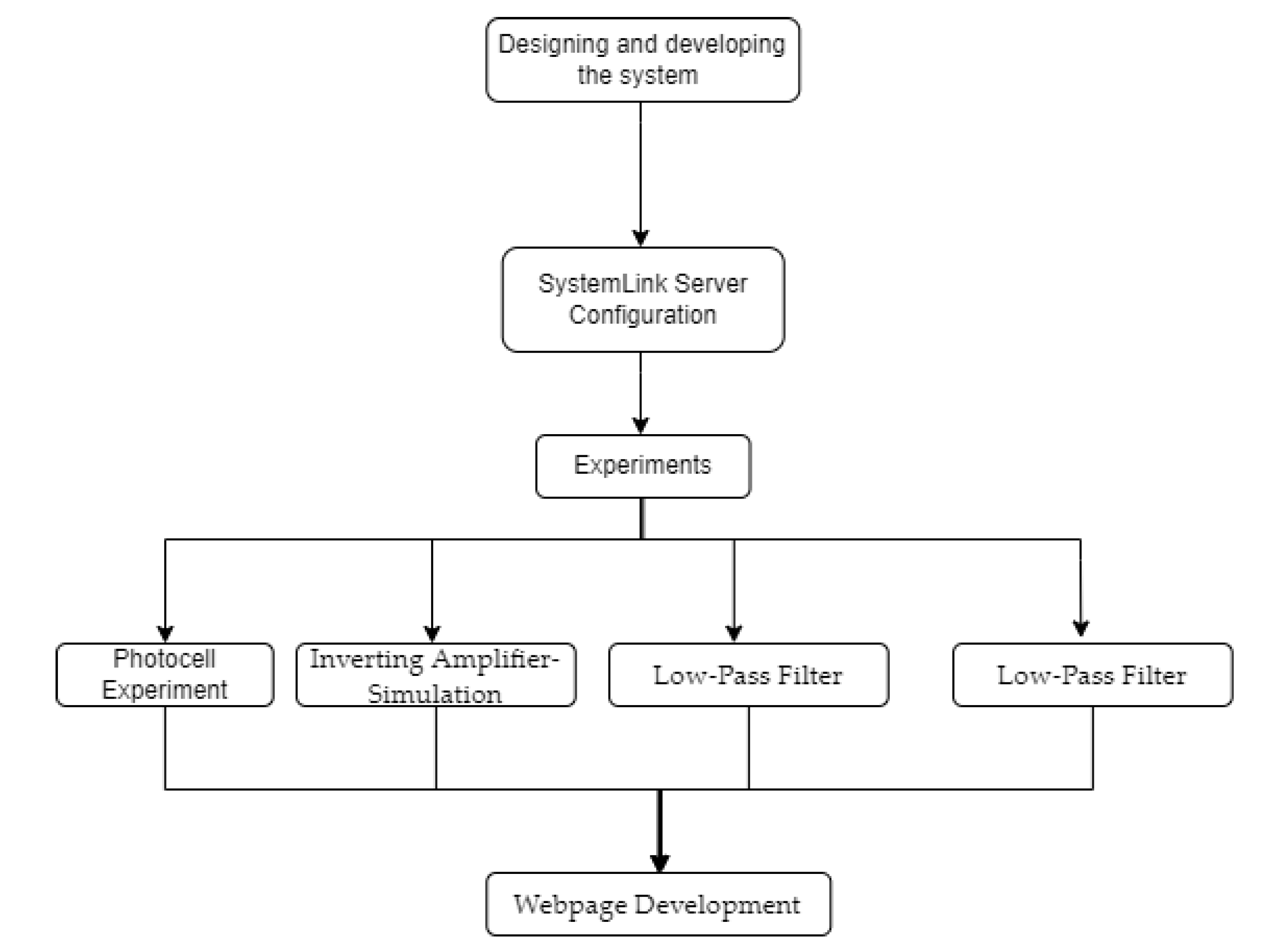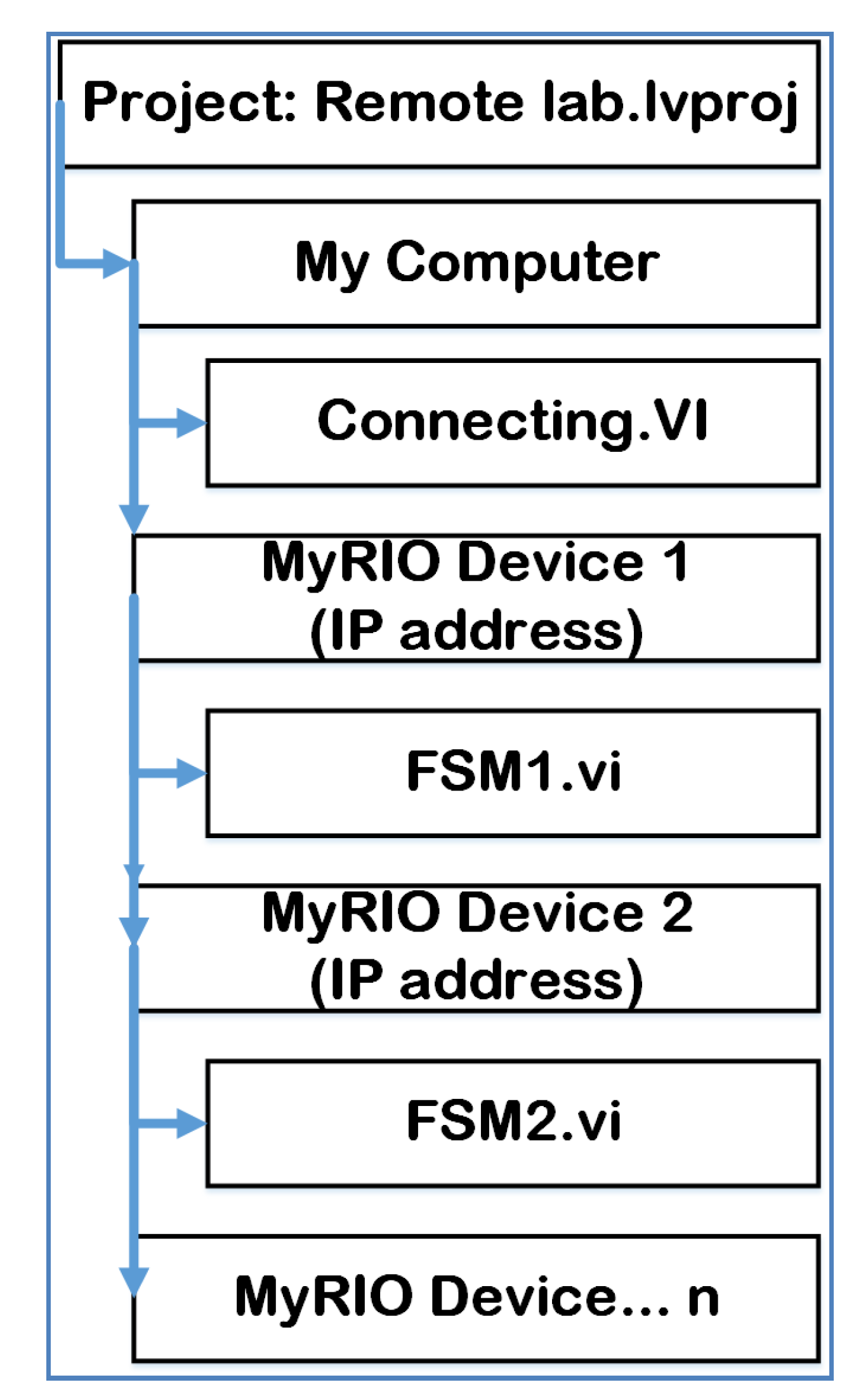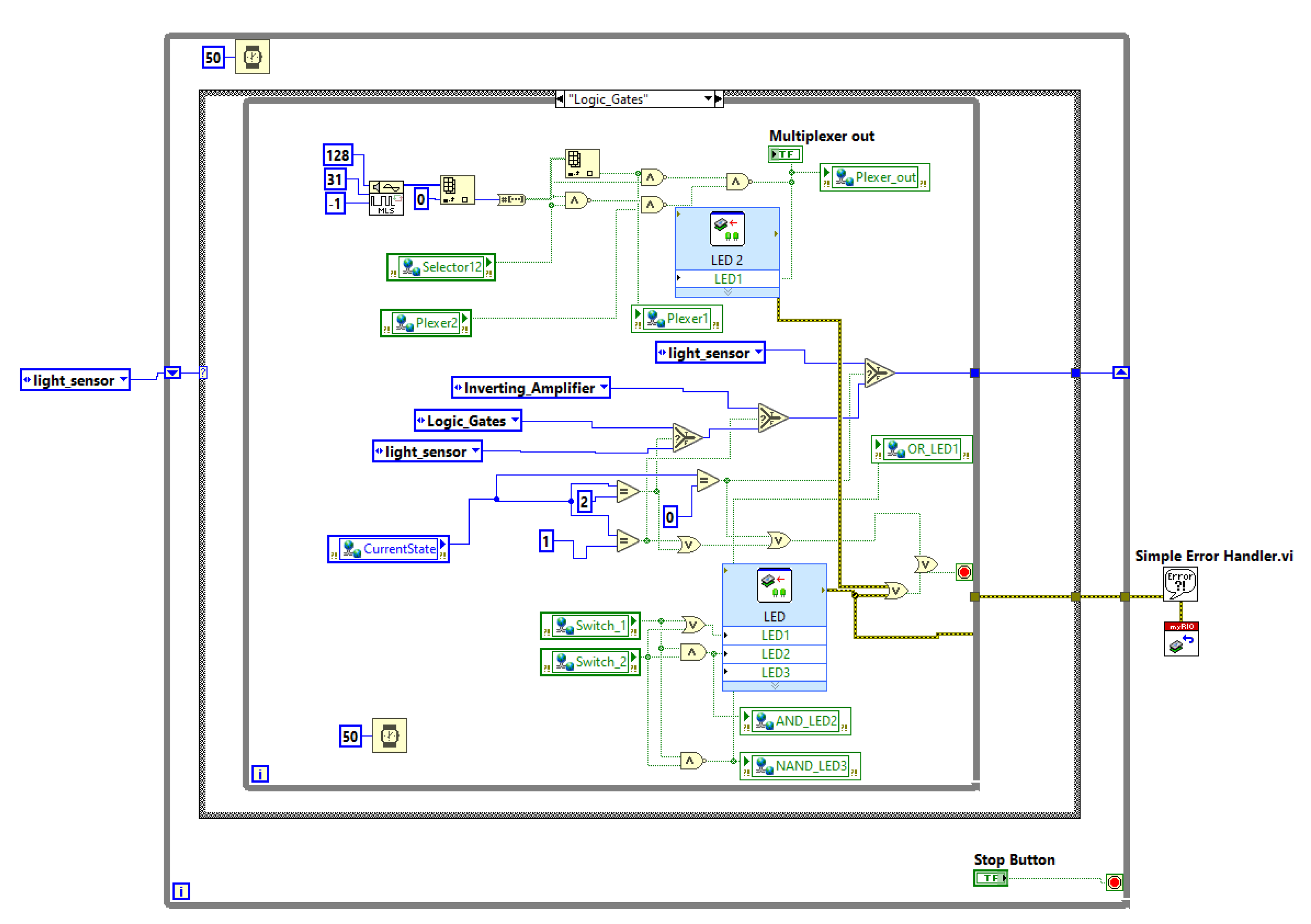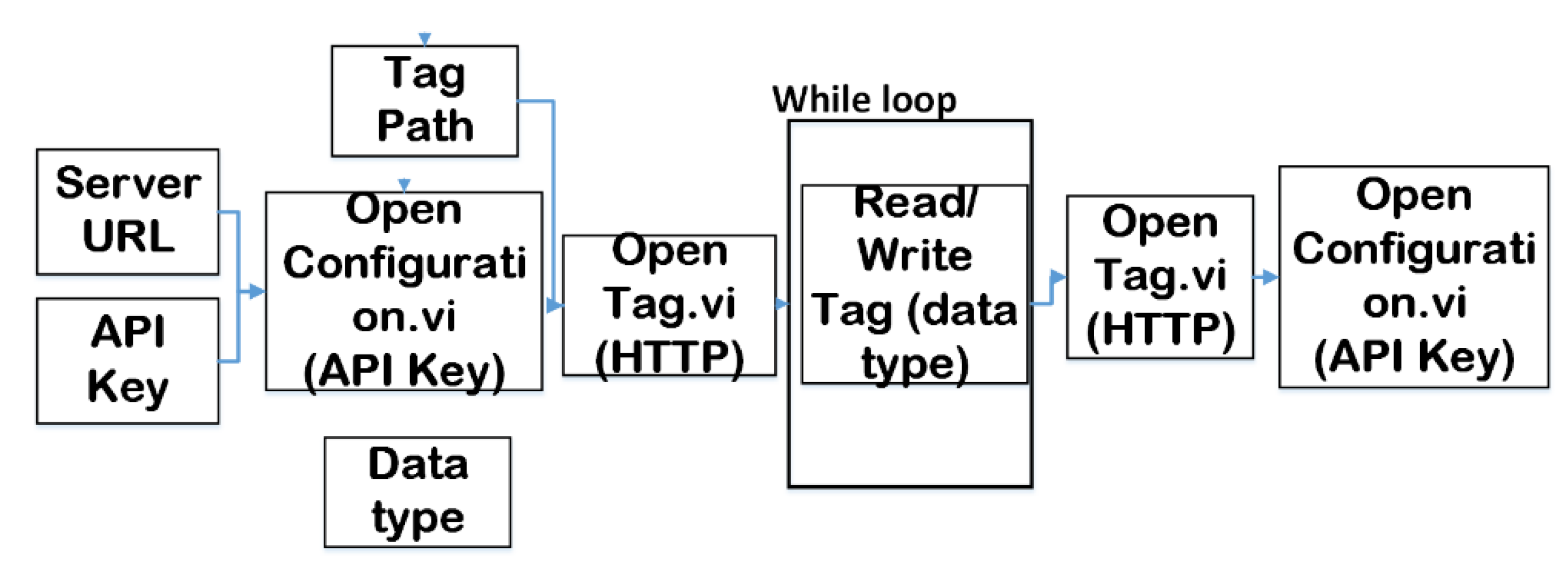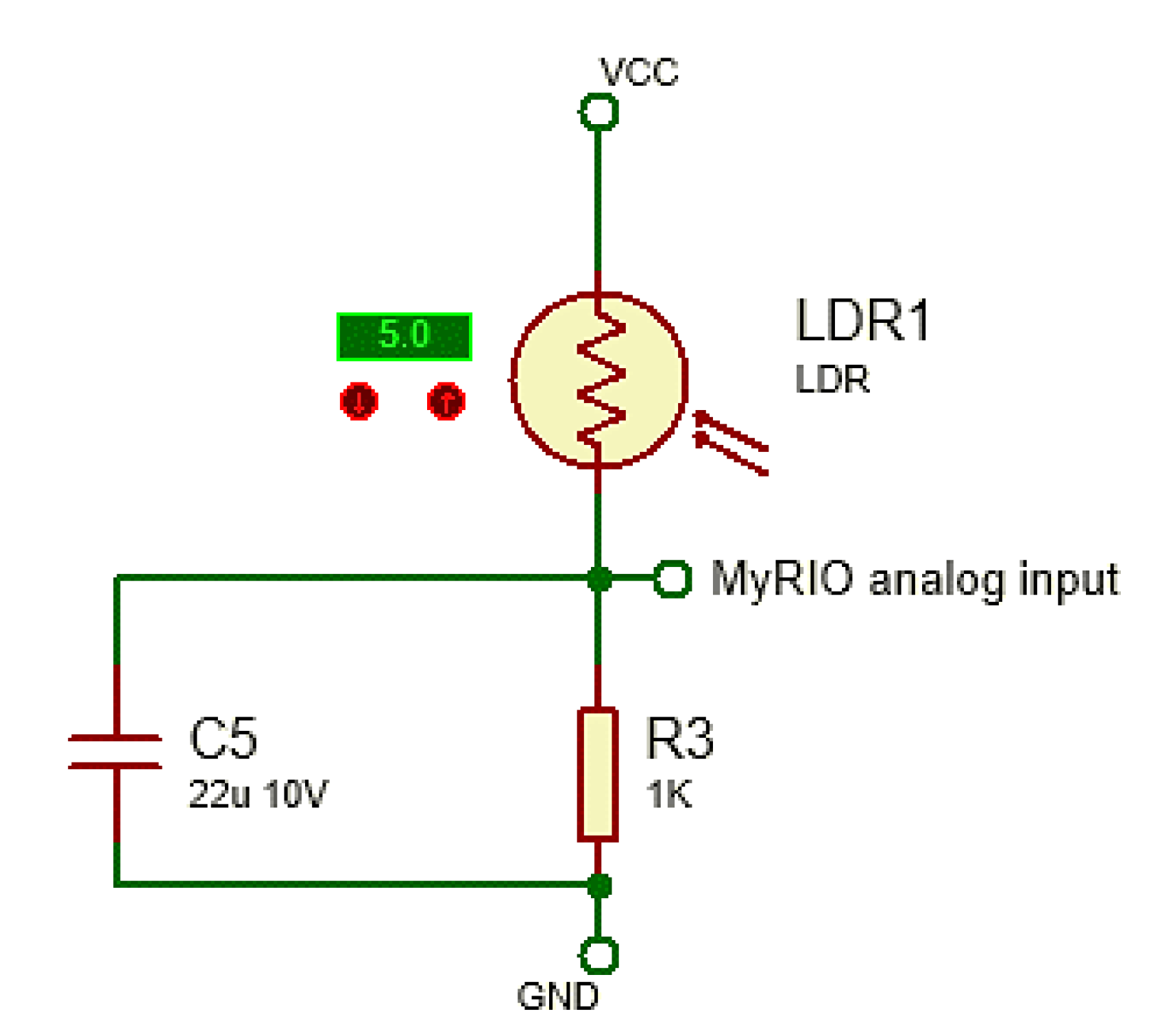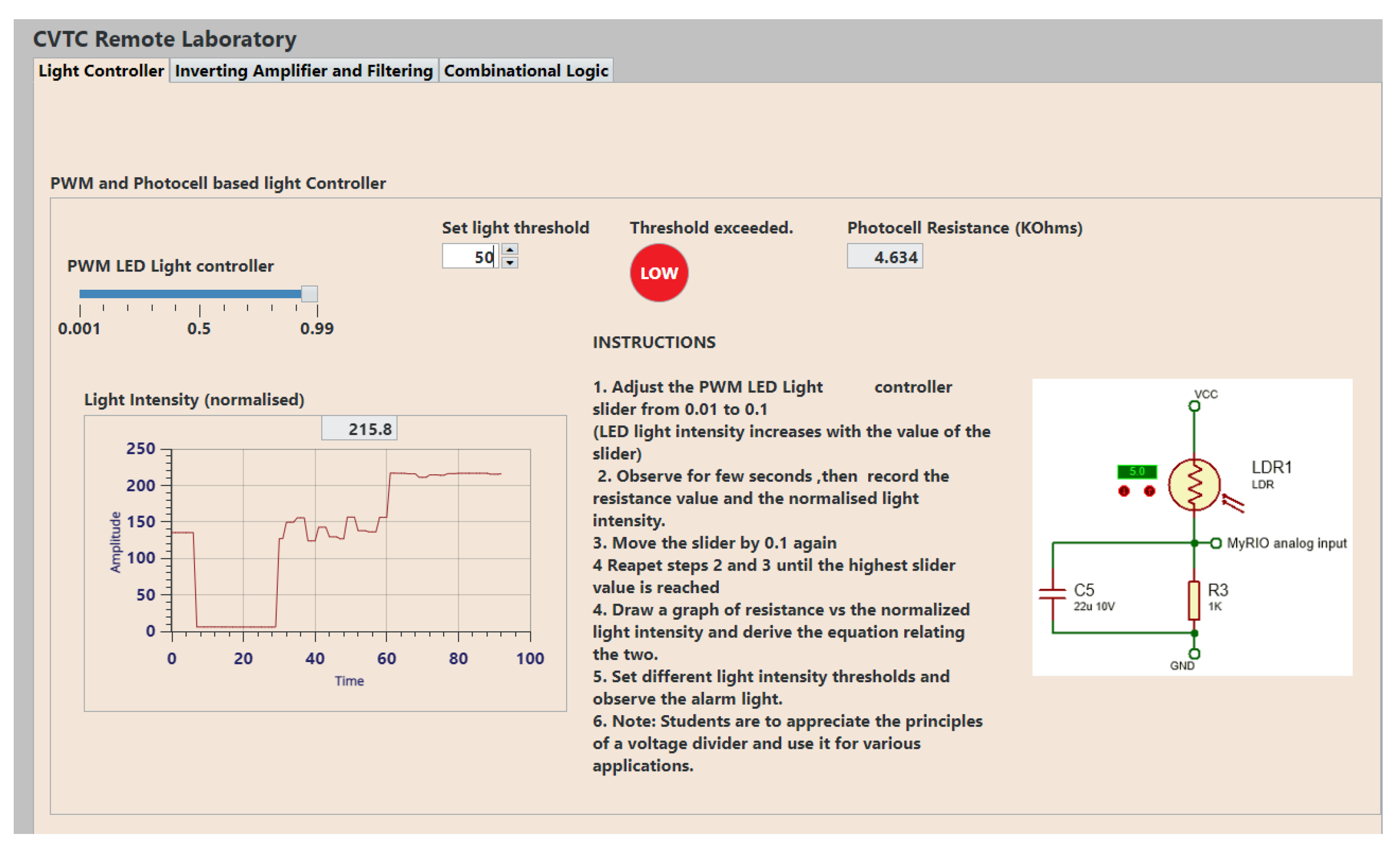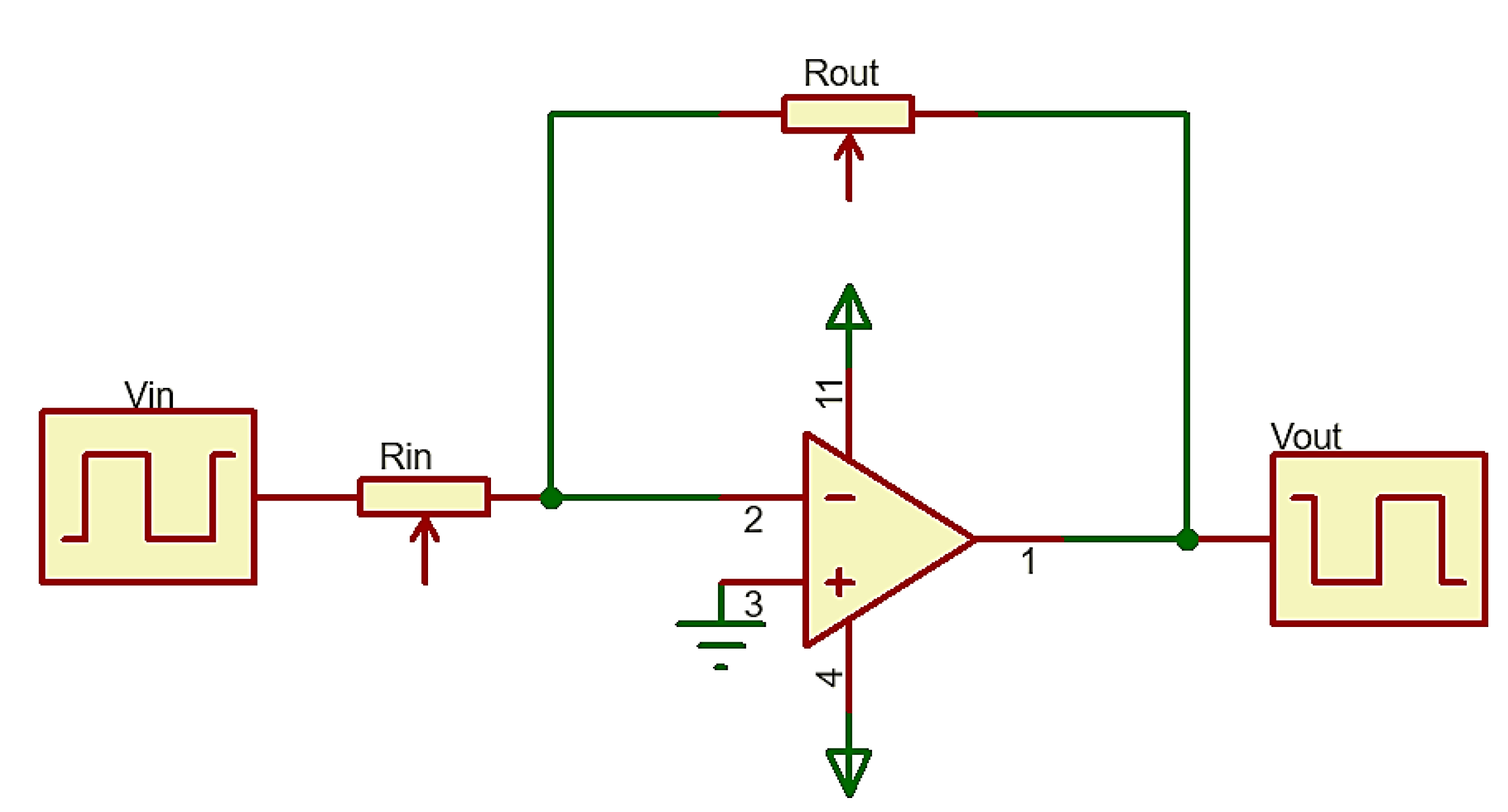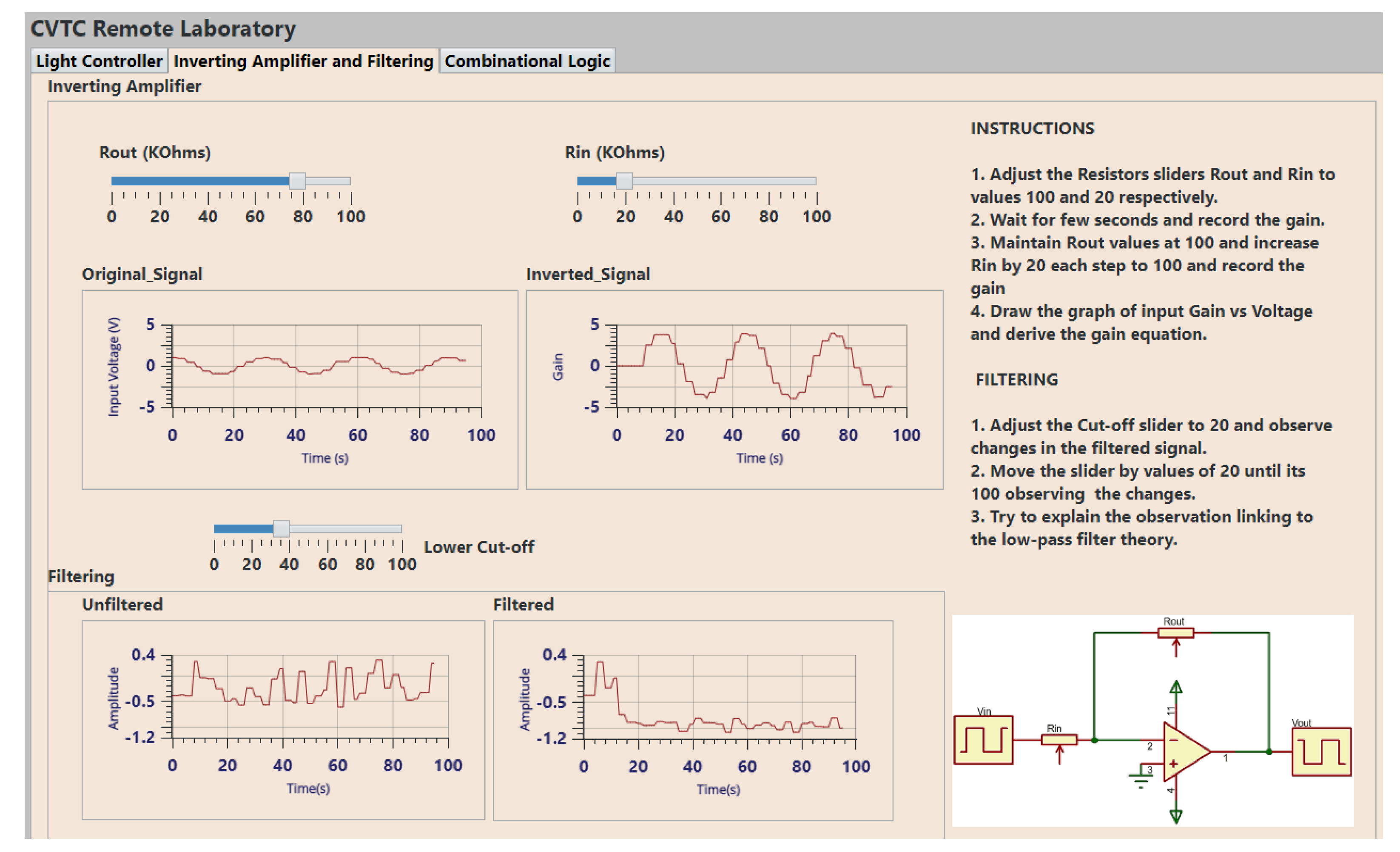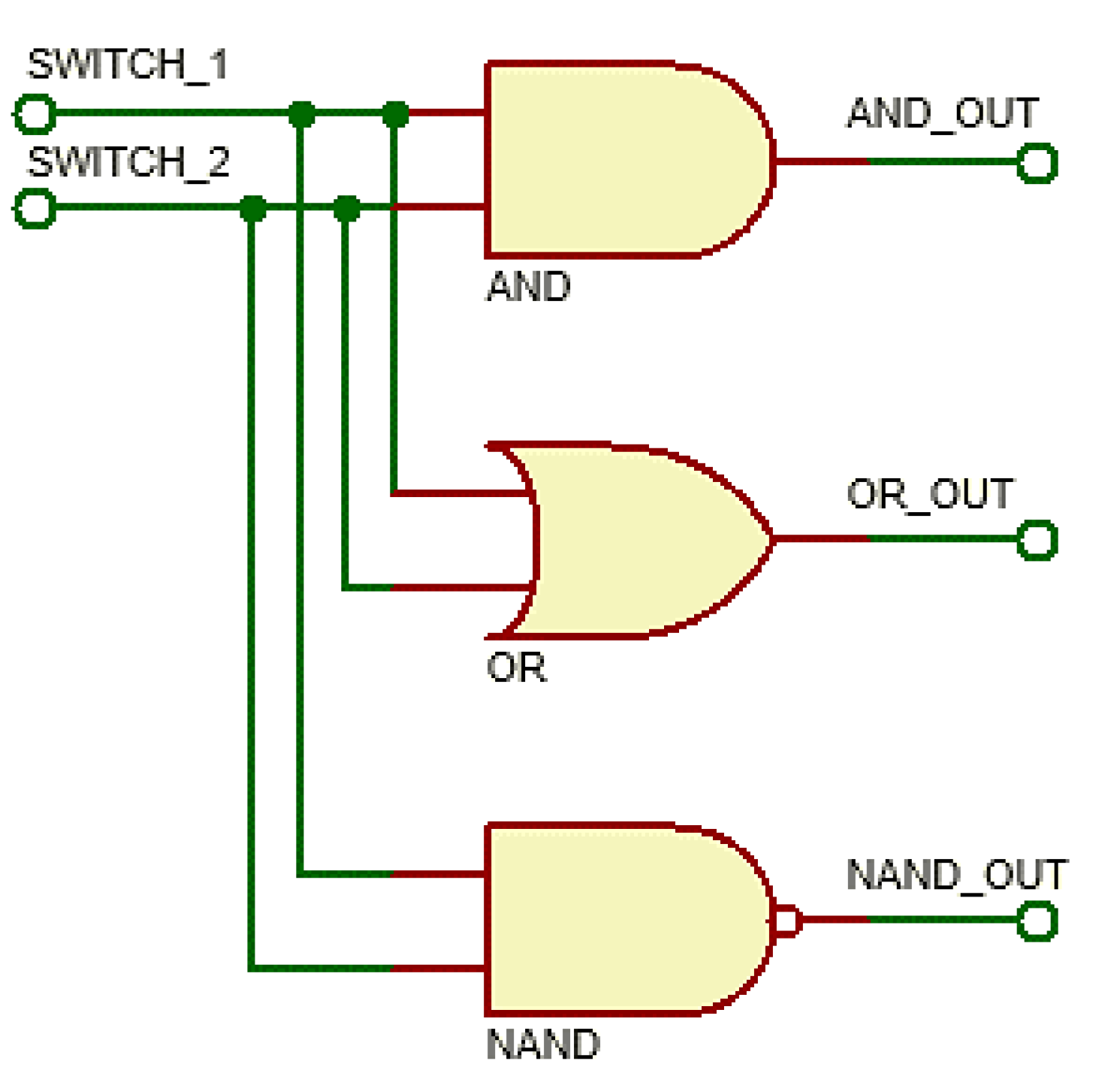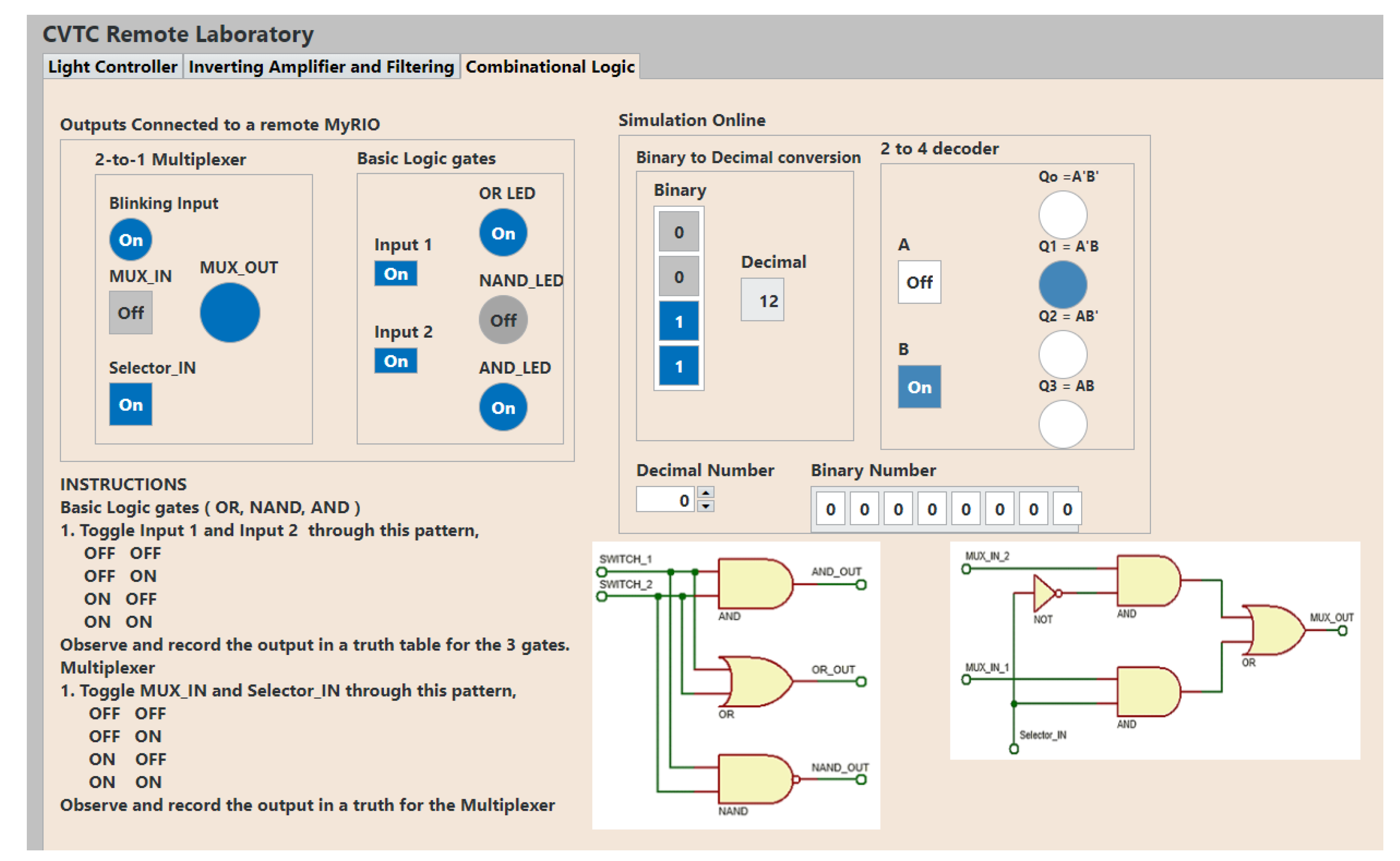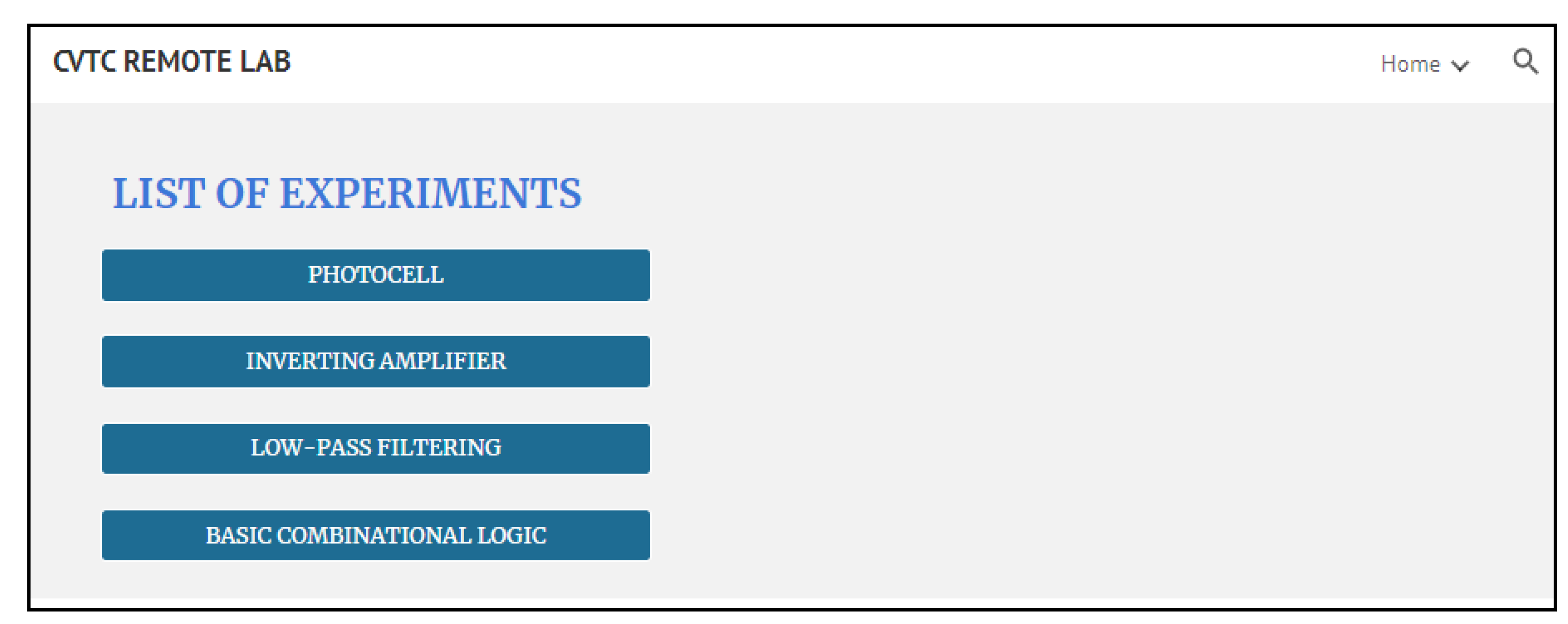1. Introduction
In a globalized world, life has become heavily dependent on the utilization of interconnected devices [
1]. An ever-increasing number of people rely on smart devices for social, business, and educational purposes. The over-dependence of today’s people on technology has led to the demand for educational institutions to be involved in continual research and development (R&D). To obtain practical proficiency in engineering training, experimentation on real equipment in labs is essential. With the rising need for remote exploration and monitoring services, a case of e-learning or computer-based remote learning (CBRL) becomes more imperative [
2]. CBRL has become increasingly essential to electronic engineering education, primarily in laboratory courses, and the COVID-19 pandemic has made the computer an indispensable tool for learning. In electronic engineering laboratory courses, learning includes the usage of integrated development environment (IDE) software and hardware development boards. When the educational embedded development boards are configurable and internet-connected, laboratory services will be versatile and remotely accessible. The main goal of this article is to devise different methods and systems for computer-based education in digital electronics, particularly for remote laboratories.
One of the major aspects of learning engineering concepts is hands-on practice. The need to shift laboratory experiments to remote and virtual platforms has been on the radar for a long time. The sudden onset of the COVID-19 pandemic meant that all learning institutions had to completely shift to online learning overnight. The need to conduct hands-on laboratories—a mainstay of engineering programs—remotely seems a practically unassailable challenge [
1]. There has been considerable research conducted on remote and virtual engineering [
3]. The study, teaching, and learning of the embedded system which forms the heart of these networked devices has never been more important. This study seeks to proffer an adaptable embedded platform. Teaching and learning have undergone a tremendous transformation in recent years. The improvement of training methodologies has been a continual process in academics and industry, in line with technological advancements.
The technological environment usually changes very quickly. A lot of previously popular technologies are being phased out. This phenomenon cannot be attributed to human or natural disasters but is instead a result of innovation and advancement of state-of-the-art technologies [
4]. Thus, the never-ending research into teaching and learning is a necessity so that education and training do not lag. This study has been necessitated partly by the need to address challenges and shortcomings raised by former electronics engineering students through a survey; these concerns, in general, apply to many engineering faculties. The study is also in line with the 2030 Agenda for Sustainable Development, which presents the primary innovation challenge for emerging countries to advance their capability to learn, take on, and spread current skills and technologies to encourage continual and comprehensive development. The goal is to improve innovation and step up concept-to-deployment in designing in line with leading universities worldwide. According to [
5], universities face the challenge of aligning their primary missions with the quick advent of technological innovations and other yet-to-be-created technologies.
The current study seeks to explore ways to enhance the offline and online teaching and learning of embedded systems laboratories and STEAM (Science, Technology, Engineering, Arts, and Mathematics) technology. It also seeks to devise new rules in the didactic process through the intended learning environment, which is essential as the COVID-19 pandemic has proven that “face-to-face” lessons are not enough. This article seeks to create a new framework for the virtual and remote learning environment and prepare young people for engineering careers.
2. Related Work
Humanity has seen disruption of its lifestyle by the breakout of the COVID-19 pandemic. Instructors in universities had to perform their laboratories and classes online [
6]. Many online system laboratories were quickly established to mitigate learning disruption, but conducting laboratories online was not without its difficulties. In African Universities, online laboratories have been recognized to facilitate learning during and after the COVID-19 pandemic period. A mixture of challenges faces the setup of such labs which are nonexistent in Southern Africa, except in South Africa. The main challenge is the cost, and hence, pooling of resources or joining existing platforms has been encouraged [
7]. The goal of instructors has been to create tools for conducting laboratories as established by [
8,
9,
10,
11,
12,
13,
14,
15,
16,
17,
18,
19].
A software platform was adopted to connect a real lab to students online [
9]. MATLAB, LabVIEW, and Arduino were used to allow students to remotely experiment with a DC motor circuit for vibrations and transient analysis. The setup is limited to one type of experiment, and it has no cloud connectivity. This study proposes a platform that covers multiple concepts in electronics by combining digital, analog, control, and IoT with access to the cloud. Other universities resorted to giving student take-home kits [
8] for introductory electrical laboratory courses. The kits consisted of all components necessary for learning basic circuits, including capacitors, resistors, LEDs, Arduino Uno, and multimeters, among others. The challenge was the lack of debugging assistance available to students.
A remote system in [
10] was established which involved remote access to an FPGA platform in the lab. The student could develop a program on their computer and only access the board to run the code through a cloud platform. The setup could not fulfill the hands-on type of simulation. This study proposes a hybrid of experiments with simulations and hardware interactions. Altalbe [
11] proposes a system to monitor the sensor data, and it allows the learner to work remotely using a mobile Android device. The physical lab consists of a mechanically configurable testing rig, while this study proposes that the use of a software-configurable embedded platform will increase the range of experiments that can be performed by students.
A remote debugging system is presented in [
14], and it can be improved by developing a dashboard that covers all experiments. Vince et al. [
15] present a simulator for power electronics control, an expansion on concepts covered, and online access is suggested to enhance the system. Another study [
17] presents a system that connects a microcontroller to a remote C# application, and a proposal is made to include an integrated hardware platform that will expand the scope of laboratory sessions. A Tinkercad platform-based system is presented in [
19], and a dedicated PCB with processing controllers is proposed in addition to a prototyping platform to expand the laboratory scope. An IoT-based laboratory is described in [
20]: the system creates a remote connection between different devices, and the authors suggest including configurable hardware to expand on several experiments and flexibility.
The authors of [
21] aim to identify and quantify the main factors affecting mechanical engineering student performance in the context of the COVID-19 pandemic, to build a generalized linear autoregressive model for predicting student grades in online learning situations in hybrid environments. The refined version of the model they developed predicts student grades with a margin ±1 with a success rate of more than 63.70%.
In another study [
22], the grade prediction in a first-semester mechanical engineering CAD module is explored. The authors developed a hybrid model with 35 features that are strongly correlated with the students’ academic performance. An artificial neural network (ANN) with three layers was selected for the model, and it achieved a 100% success rate.
Z. Kanetaki et al. [
23] presented a case study concerning the evaluation of the online task assignment of students, using Microsoft Teams. Their aim was to determine whether it can be used to avoid potential problems which can occur during the teaching process. This study revealed the special features of fully online teaching specifically, and its role in improvement of assessment using digital tools.
3. Materials and Methods
This section describes in detail the materials and methods used for this experiment;
Figure 1 illustrates the 4 subsections.
3.1. Designing and Developing the System
The developed CVTC remote laboratory is a platform to access experiments hosted on remote NI myRIO hardware. The experiments are accessed through the NI Web VI hosted on a SystemLink server. The delayed test led to a decision to host the lab web VIs on the SystemLink server since it offers better performance than the cloud platform. The link to access the lab is
https://cvtc.unitbv.ro (accessed on 20 September 2022). The student can select an experiment to conduct using a selector tab on the interface. Each lab has its specific learning objectives.
Figure 2 illustrates the laboratory platform structure. It contains several interconnected myRIO devices that can be accessed remotely. The myRIO devices are connected to the instructor PC through the USB cable or Wi-Fi protocol (
Figure 3). In the LabVIEW project hierarchy, the deployed FSM codes are under the myRIO devices, and the intermediary code is above the myRIO device (
Figure 4).
Figure 3 is a representation of the system connection overview. Each rounded rectangle represents a hardware or server platform. For instance, MyRIO Device 1 contains the state, and the instructor PC has the indicated software installed. The transition arrows show the flow of information from one platform to another. For example, the movement of data from the PC to the Web VI hosted in the SystemLink cloud is enabled by configuring the server URL, API key, and associated tags.
Each myRIO device contains a LabVIEW-based finite state machine (FSM) code deployed inside and can accommodate multiple experiments. The interfaces are observable on a single tab in a web interface. The FSM technique enables the selection of specific experiments to run while others are on hold, making the platform configurable. Experiment codes from the same state execute independently of each other.
Figure 5 illustrates the code for one of the states (Logic Gates).
The finite state machine LabVIEW code from different devices execute independently from one another (
Figure 6).
The lab setup is such that myRIO devices are connected to the computer either by cable or Wi-Fi. Each myRIO device contains a finite state machine-based VI deployed in it. An FSM can contain any number of states. There are also VIs which execute in the PC and communicate with VIs in the myRIO devices and SystemLink cloud tags. The FSM codes deployed inside myRIO devices transmit data to and from the code running in the PC through global variables. The code running in the PC functions as a data transfer intermediary between the codes deployed in the myRIO device and the web user interface. The intermediary LabVIEW code executing in the PC receives data through the global variables from the myRIO device and transfers them to the web interface through SystemLink tags. Data transfer from LabVIEW to SystemLink cloud requires an application programming interface (API) key and cloud server URL specified on the open configuration VI in LabVIEW. SystemLink tags are created in SystemLink cloud and SystemLink server, and each tag has a unique name and a data type. The tag name and data type are matched and specified on the tag VI in LabVIEW (
Figure 7).
The data from LabVIEW are sent to a Web VI hosted on SystemLink server or SystemLink cloud. The Web VI is created in NI G Web development software which employs the graphical language used in LabVIEW. The Web VI receives data from tags using the same configuration as LabVIEW.
The front panel of the Web VI is customized to suit the required user interface corresponding to the selected experiments. The steps to create the Web VIs are as follows:
Design the G Web development software block diagram to receive indicator data from SystemLink tags.
Use the G Web block diagram to send control data to SystemLink tags.
Configure appropriate indicators for received data.
Design a tab-based front panel to enable a choice of labs in synchronization with the finite state machine configured in the myRIO device.
Evaluate the design on localhost.
Build the Web VI into a nipkg file.
Upload the file on SystemLink server or cloud platform.
3.2. SystemLink Server Configurations
The NI Web Server Configuration wizard was used to configure the SystemLink server. The configured aspects are as shown in
Figure 8.
The configured aspects included users’ roles, authentication, and connections.
3.3. Experiments
This section describes some of the experiments that were created for the laboratory platform.
There are objectives that are common to all experiments. This task involves writing a G web code which can send and receive data from the cloud using tags, server URL, an appropriate data type, and an API key for security. After performing the experiments, the students should be able to:
Appreciate the role of SystemLink in data storage and transfer.
Understand how to read and write to SystemLink tags.
Understand the relationship between a tag and its path.
Appreciate the relationship between tags, indicators, and controls.
Built VIs to interact with data from SystemLink server.
Understand the connection of hardware circuits to the cloud platform (
Figure 1) and build projects based on this principle.
3.3.1. Photocell Experiment
A physical circuit for the
Figure 9 setup exists in the remote lab. The setup consists of a photocell connected in a voltage divider circuit which responds to varying light intensity. The source of the light is an LED whose intensity is varied using the PWM principle. The PWM variation is achieved through the PWM express VI in myRIO toolkit in LabVIEW. As the incident light changes in intensity, so does the output voltage connected to a myRIO analog input. The PWM variation is emulated on the web user interface. The output voltage is then transferred to the web interface through global variables and tags and is visualized graphically. The laboratory platform can have several of these circuits accessible independently on one or several myRIO boards (
Figure 10).
The steps of the experiment are shown on the user interface. After performing this experiment, the learner will be able to:
Understand the characteristics of a photocell (the relationship between light illumination and resultant resistance).
Appreciate the Pulse Width Modulation Concept.
Understand the working principle of a voltage divider rule.
Build a simple alert system to indicate light thresholds limits.
3.3.2. Inverting Amplifier Simulation
The experiment (
Figure 11) illustrates the working principle of an inverting amplifier. The setup consists of an inverting operational amplifier input voltage, input resistance, output resistance, and an output voltage. The inverting amplifier is simulated in LabVIEW, and the functionality is emulated on the web user interface. A constant input voltage is generated, and input resistance is kept constant as output resistance is varied, thereby changing the output gain. LabVIEW can be configured to emulate this setup multiple times, and students can access the several copies independently.
By the end of this experiment, the student will be able to:
Understand the characteristics of an inverting amplifier.
Appreciate the effect of resistor ratio in the gain of an amplifier.
Build a simple alert system to indicate voltage thresholds limits.
Differentiate between inverting and non-inverting amplifiers.
From
Figure 12, the gain of an inverting amplifier is expressed as:
Steps of the experiment:
Open the Experiment User interface.
Choose the Lab 3 and 4 tab options (
Figure 12).
Adjust the resistor 1 and resistor 2 sliders to 100, wait for a few seconds, and then record the gain steady value (i.e., Inverted Signal).
Maintain resistor 2 at a value of 100 and change resistor 1 by a value of 20.
Repeat steps (3), (4), and (5) down to the value of 20.
Draw the graph of resistor 1 values versus gain.
Postulate what a non-inverting amplifier graph would look like.
3.3.3. Low-Pass Filter
This experiment illustrates the working principle of a generic low-pass filter. By the end of this experiment, the student will be able to:
Understand the characteristics of a low-pass filter.
Appreciate the effect of a cutoff frequency in low-pass filters.
Differentiate between low-pass and high-pass filters.
Steps of the experiment:
Open the Experiment User interface.
Choose the Lab 3 and 4 tab options (
Figure 12).
Adjust the cutoff frequency from a value of 0 in steps of 10 up to 100.
Wait for a few seconds and observe the results.
Postulate how a high-pass filter would behave.
3.3.4. Basic Logic Gates and Multiplexer
The experiment illustrates the working principle of basic logic gates and a 2-to-1 multiplexer. The logic gates setup consists of three logic gates, an OR gate, AND gate, and NAND gate. The logic gates are connected to three outputs and to two inputs which are toggled from 00 to 11. Each logic gate output is observed on the web interface and on the myRIO device LED in the lab. The multiplexer consists of the 2 inputs and selector input which are connected to logic gates network, forming a 2-to-1 multiplexer. The output reflects the status of each input depending on the selector state (0 or 1). The output shows a blinking LED or the state of the other input (ON or OFF). These setups can be replicated to enable independent access by different students.
By the end of this experiment, the student will be able to:
Steps of the experiment:
Open the Experiment User interface.
Toggle Switch_1 and Switch_2 using the pattern shown in
Table 1 and fill in the results in the table.
Record whether the logic gates indicators are red (on) or green (off).
Compare results with truth tables in textbooks.
Toggle Selector_IN and MUX_IN_2 using the pattern shown in
Table 2 and fill in the results.
Record whether the MUX_OUT indicator is red (on) or green (off).
Compare results with truth tables in textbooks.
3.4. Web Page Development
This section outlines the development of a website hosting various labs. The labs were selected to show the proof of concept of the remote laboratory platform ecosystem. The website is found at:
https://sites.google.com/view/cvtc-lab/home (accessed on 20 September 2022). The home page is shown in
Figure 16. The page gives options to go to different labs. The Website hosts both myRIO-based remote experiments and Multisim-based virtual experiments.
4. Results and Discussions
This section provides the conclusion to this article and suggests future study opportunities and recommendations. The study was undertaken by the Center for Valorization and Transfer of Competence (CVTC) at the Transylvania University of Brasov, which enjoys a fruitful partnership with Cypress-Infineon and NI Romania, fostered by the current center president Doru Ursuțiu. The student board and the teacher’s platform page simulation have been tailor developed from various reference designs and hardware and software resources from those partners. The main advantage was the permission to develop from the offered software and hardware resources platforms. Student feedback is an ongoing process and is being conducted on Google forms link:
https://forms.gle/usQLK4GuhNLT47aJ9 (accessed on 3 October 2022).
The current study achieved the following innovative and original ideas:
LabVIEW is a great tool for engineering learners as it offers an intuitive graphical programming environment. The graphic methodology to programming bodes well with engineering learners who are used to demonstrating solutions utilizing process diagrams. The software also proffers a straightforward way of FPGA designing by abstracting many aspects and allowing students to concentrate on their algorithms. The SystemLink environment presents an appropriate platform for performing laboratories through the internet and applying SystemLink cloud services and dashboard mobile application.
The blending of LabVIEW, SystemLink server, SystemLink cloud, and NI Web Vis on this laboratory platform is an innovative ecosystem for IoT designs and remote laboratories. The ecosystem is suitable for learners with inadequate access to costly laboratory equipment, and it is a superb platform for remote laboratories. NI real-time hardware devices with more than 512 MB RAM can connect with LabVIEW and SystemLink cloud platform to structure remote educational laboratories and industrial process control.
5. Conclusions
The designed laboratory platform was based on the NI myRIO devices to deliver a valuable experimental online platform for electronic engineering lab classes. The platform is a flexible and adaptable design since different sensors can be substituted with each other through the Pmod connectors. The integrated sensors supplied by the Diligent company offer straightforward connections throughout prototyping. The myRIO device expansion port (MXP) connector has interior protection; learners only focus on top-level circuit design. The existence of the FPGA chip and ARM processor in myRIO makes it feasible to implement different functionalities with variable intricacy.
The methodology expressed in this study could be considered a proof of concept, inspiring related projects that may aid a broad range of engineering and technology learners all over the world. The easy-to-program software and hardware, combined with the easy-to-connect solutions, are requirements for a post-COVID-19 education world, where the necessity for information transfer and assimilation is facing the trials of social distancing. The study contributes knowledge on learning methods in the post-COVID-19 era and demonstrates how to conduct STEAM classes using a combined platform for hardware and simulated labs. The development of an expandable, inexpensive, and configurable remote platform challenges the way professors, especially in the sub-Saharan region, conduct experiments. The complaints about inadequate resources could be solved as universities can come together to develop powerful combined platforms for their faculties. Furthermore, an LDR camera will be added so that the students can observe the physical devices live.
Author Contributions
Conceptualization, T.C., H.A.M. and D.U.; methodology, C.S. and H.H.; software, T.C. and H.A.M.; validation, D.U., C.S. and H.H.; formal analysis, T.C. and H.A.M.; investigation, T.C.; resources, T.C., H.A.M. and D.U.; data curation, H.A.M.; writing—original draft preparation, T.C. and H.A.M.; writing—review and editing, D.U. and C.S.; visualization, D.U., C.S. and H.H.; supervision, D.U.; project administration, C.S.; funding acquisition, D.U. All authors have read and agreed to the published version of the manuscript.
Funding
This research received no external funding.
Institutional Review Board Statement
Not applicable.
Informed Consent Statement
Not applicable.
Data Availability Statement
The data presented in this study are available on request from the corresponding author.
Acknowledgments
We would like to express our deep appreciation to the National Instruments company for providing us with LabVIEW and SystemLink licenses, thus facilitating our experiments.
Conflicts of Interest
The authors declare no conflict of interest.
References
- Stuck at Home, Engineers Binge on Technical Content. In Fierce Electronics’. Available online: https://www.fierceelectronics.com/electronics/stuck-at-home-engineers-binge-technical-content (accessed on 18 April 2022).
- Markan, C.M.; Kumar, G.; Mittal, S.; Gupta, P.; Gupta, S.; Satsangi, A.; Gupta, A.; Kapur, G. Remote Triggered Analog Communication Laboratory for E-Learning. Int. J. Online Biomed. Eng. 2013, 9, 8. [Google Scholar] [CrossRef]
- Auer, M.E.; Zutin, D.G. Online Engineering & Internet of Things: Proceedings of the 14th International Conference on Remote Engineering and Virtual Instrumentation REV 2017, New York, NY, USA, 15–17 March 2017, 1st ed.; Springer Publishing Company, Incorporated: Berlin/Heidelberg, Germany, 2017. [Google Scholar]
- Khan Pathan, A.S. Technological advancements and innovations are often detrimental for concerned technology companies. Int. J. Comput. Appl. 2018, 40, 189–191. [Google Scholar] [CrossRef]
- The Role of Universities in a Highly Technological Age. Available online: https://www.universityworldnews.com/post.php?story=20191023081415452 (accessed on 18 April 2022).
- Soh, W.S. Experiential Learning through Remote Electrical Engineering Labs During the COVID-19 Pandemic. In Proceedings of the 2021 IEEE International Conference on Engineering, Technology Education (TALE), Wuhan, China, 5–8 December 2021; pp. 1–5. [Google Scholar] [CrossRef]
- Sawahel, W. COVID-19 Drives the Development of Online Laboratories. 2020. Available online: https://www.universityworldnews.com/post.php?story=20200715130543961 (accessed on 27 July 2022).
- Kurukunda, S.; Trigona, C.; Baglio, S. Laboratory Activity during COVID-19 as a “Virtual Experience”: Restriction or Chance? In Proceedings of the 2020 17th International Multi-Conference on Systems, Signals Devices (SSD), Monastir, Tunisia, 20–23 July 2020; pp. 349–353. [Google Scholar] [CrossRef]
- Panicker, R.C.; John, D. Fully Remote Project-Based Learning of Hardware/Software Codesign. In Proceedings of the 2021 IEEE Frontiers in Education Conference (FIE), Lincoln, NE, USA, 13–16 October 2021; pp. 1–5. [Google Scholar] [CrossRef]
- Ramya, G.; Purushothama, K.; Prakash, K.R. Design and Implementation of IoT Based Remote Laboratory for Sensor Experiments. Int. J. Interact. Mob. Technol. iJIM 2020, 14, 227–238. [Google Scholar] [CrossRef]
- Altalbe, A.A. Performance impact of the simulation-based virtual laboratory on engineering students: A case study of Australia virtual system. IEEE Access 2019, 7, 177387–177396. [Google Scholar] [CrossRef]
- Svatos, J.; Holub, J.; Fischer, J.; Sobotka, J. Online teaching at CTU in Prague aka university under COVID restrictions. Meas. Sens. 2021, 18, 100121. [Google Scholar] [CrossRef]
- Velihorskyi, O.; Khomenko, M.; Nesterov, I. Remote Debugging of Embedded Systems in STM32CubeMonitor. In Proceedings of the MC&FPGA-2020 Conference, Kharkiv, Ukraine, 25–26 June 2020. [Google Scholar] [CrossRef]
- Kaewmanee, W.; Yodwong, B.; Sikkabut, S.; Phattanasak, M.; Guilbert, D. A New Low-cost Hardware-in-the-Loop Simulator for Control of Power Electronics Systems Laboratory. In Proceedings of the 2021 Research, Invention, and Innovation Congress: Innovation Electricals and Electronics (RI2C), Bangkok, Thailand, 1–3 September 2021; pp. 233–237. [Google Scholar]
- Vince, T.; Bereš, M.; Kováčová, I.; Molnár, J.; Fecko, B.; Dziak, J.; Tomčiková, I.; Guzan, M. IoT Implementation in Remote Measuring Laboratory VMLab Analyses. J. Univers. Comput. Sci. 2020, 26, 1402–1421. [Google Scholar] [CrossRef]
- Jacko, P.; Guzan, M.; Kalinov, A. Remote Microcontroller Scanner Design for STM32 Microcontrollers Used to Distance Education Form. In Proceedings of the 2021 IEEE International Conference on Modern Electrical and Energy Systems (MEES), Kremenchuk, Ukraine, 21–24 September 2021; pp. 1–6. [Google Scholar]
- Alves, G.R.; Marques, A.; Bento da Silva, R. Lab-based Education. In Proceedings of the 9th International Conference on Technological Ecosystems for Enhancing Multiculturality (TEEM’21), Barcelona, Spain, 26–29 October 2021; pp. 533–535. [Google Scholar]
- Praselia, D.; Handayani, A.N.; Wibawanto, S.; Mustika, S.N.; Kurniawan, W.C.; Asmara, R.A. Design and Development of Online Media Learning on Analog Electronics Course under COVID-19. In Proceedings of the 2021 International Conference on Electrical and Information Technology (IEIT), Malang, Indonesia, 14–15 September 2021; pp. 45–49. [Google Scholar]
- Martin, S.; Fernandez-Pacheco, A.; Ruipérez-Valiente, J.A.; Carro, G.; Castro, M. Remote Experimentation Through Arduino-Based Remote Laboratories. IEEE Rev. Iberoam. Tecnol. Aprendiz. 2021, 16, 180–186. [Google Scholar] [CrossRef]
- Espinoza, J.V.; Alama, W.I.; Bohórquez, J.S.; Amaya, I.B. Implementation of a pilot plant for the integral development of remote laboratories. IEEE Rev. Iberoam. Tecnol. Aprendiz. 2021, 16, 11–20. [Google Scholar] [CrossRef]
- Kanetaki, Z.; Stergiou, C.; Bekas, G.; Jacques, S.; Troussas, C.; Sgouropoulou, C.; Ouahabi, A. Grade Prediction Modeling in Hybrid Learning Environments for Sustainable Engineering Education. Sustainability 2022, 14, 5205. [Google Scholar] [CrossRef]
- Kanetaki, Z.; Stergiou, C.; Bekas, G.; Troussas, C.; Sgouropoulou, C. A Hybrid Machine Learning Model for Grade Prediction in Online Engineering Education. Int. J. Eng. Pedagog. 2022, 12, 4–24. [Google Scholar] [CrossRef]
- Kanetaki, Z.; Stergiou, C.; Bekas, G.; Troussas, C.; Sgouropoulou, C. Evaluating Remote Task Assignment of an Online Engineering Module through Data Mining in a Virtual Communication Platform Environment. Electronics 2022, 11, 158. [Google Scholar] [CrossRef]
| Publisher’s Note: MDPI stays neutral with regard to jurisdictional claims in published maps and institutional affiliations. |
© 2022 by the authors. Licensee MDPI, Basel, Switzerland. This article is an open access article distributed under the terms and conditions of the Creative Commons Attribution (CC BY) license (https://creativecommons.org/licenses/by/4.0/).
